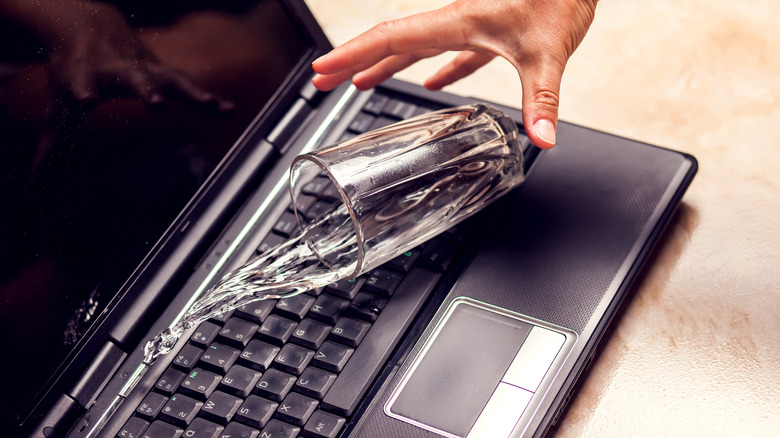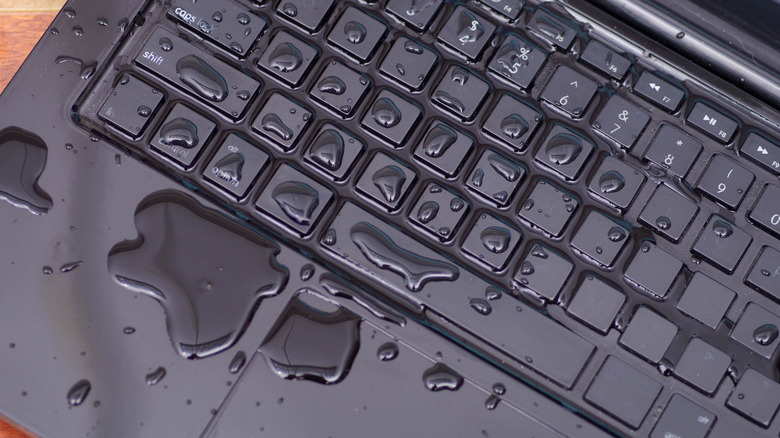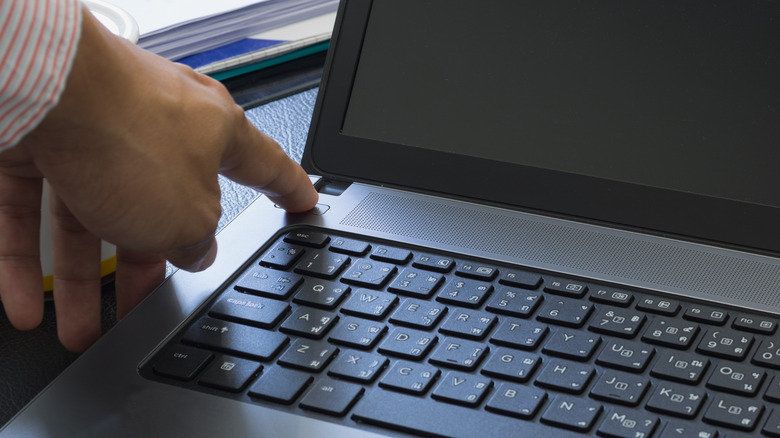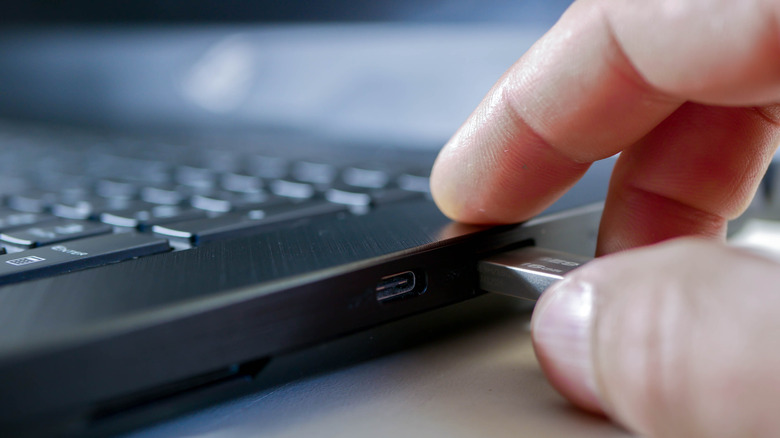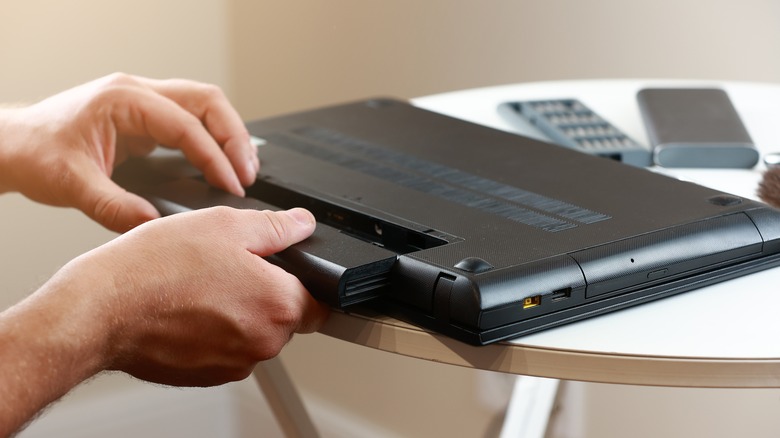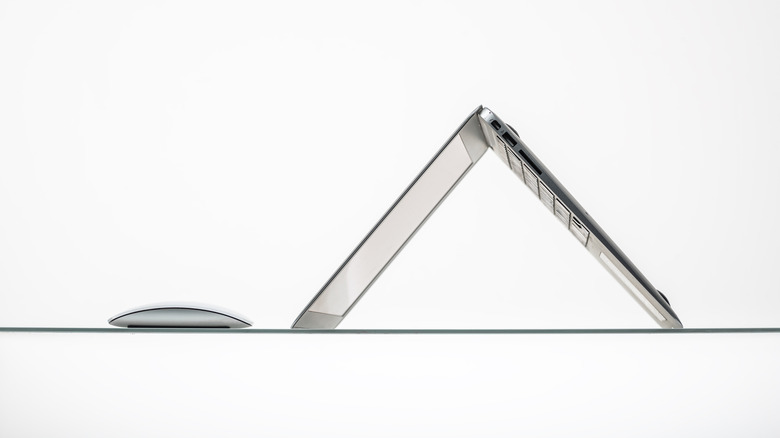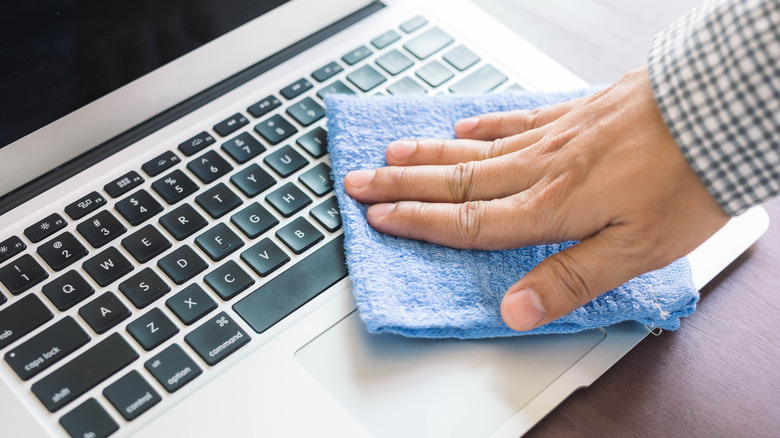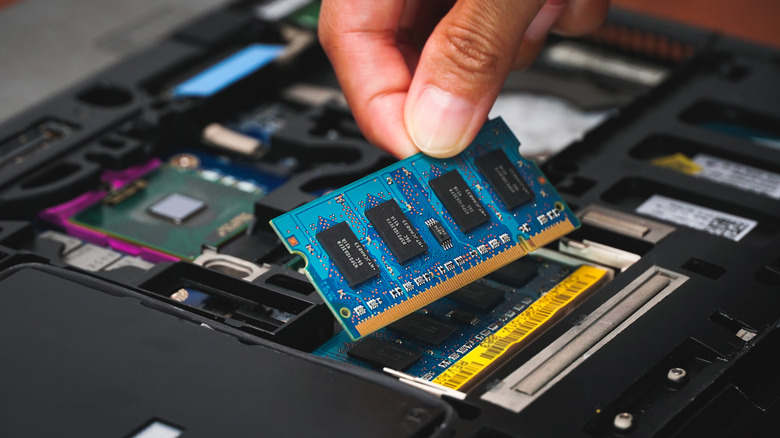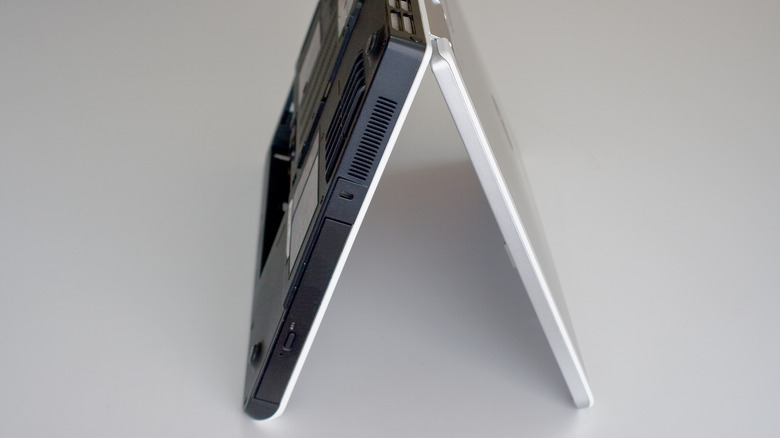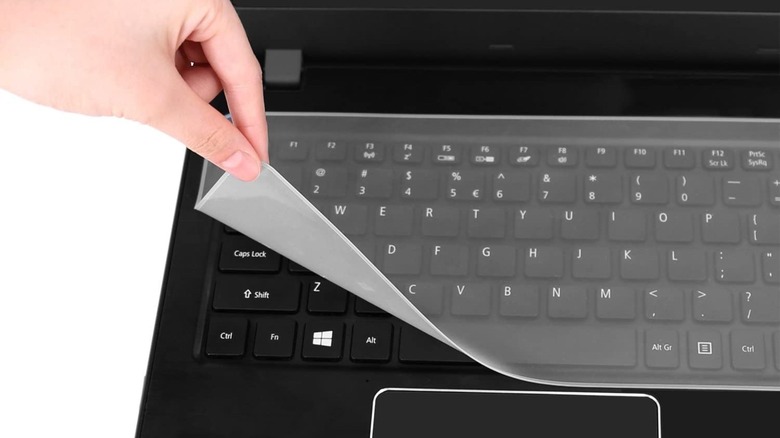What To Do If You Spill Water On Your Laptop
Spilling water on your laptop can trigger an immediate fight, flight, or freeze response in you, but rest assured, there are steps you can take to dry your laptop and hopefully salvage it. For the best results, you need to act quickly. However, acting rashly without thinking will cause more damage than taking a few seconds to breathe and calm yourself down before starting the process of cleaning and drying your laptop.
While you're working on your laptop, it's important to go through all the potential outcomes. In many cases — mostly with minor spills, not major spills — your laptop can be saved. The less liquid you spill, the better your laptop's chance of surviving the accident. There's also a chance you may have to replace your laptop entirely and recycle your old one. Or, you could land somewhere in between these two extremes and simply need to replace a wet battery or manage to save your data, but not your laptop as a whole.
The first step? Assess your situation to see how bad the spill is and where to start the recovery process.
Quickly assess the damage
If you've spilled a small amount of water on your laptop and the spill never left your desk, skip this part and start the salvaging process. But if you spilled a larger amount of water near your laptop's power cord or the outlet it's plugged into, take extreme caution. Yes, your laptop is important, but it's not as important as your own personal safety — and electrocution is a real possibility, according to the New York Times.
In this situation, you'd need to cut the power to that outlet directly from your circuit breaker before you touch anything. You'd also want to go this route if your clothes are wet, your house was flooded and you're standing in water, or your laptop is actively steaming, bubbling, hissing, or making any other worrisome sounds. If the situation is severe enough, you might decide your laptop isn't worth trying to save — and that's okay! Your safety comes first.
Another question you need to answer before trying to save your laptop is whether you spilled water or a different liquid. While water damage to a laptop is no joke, spilling a liquid that's more sugary or acidic is decidedly worse. Liquids like coffee, soda, or lemonade are better conductors of electricity and can cause more damage and corrosion to your laptop. Unless you feel comfortable trying to clean more corrosive liquids off your laptop, it's a smart idea to take it to a repair professional after turning it off.
Turn your laptop off completely
Whether you decide to take your laptop to a professional or to minimize the damage on your own, the very first thing you need to do is turn your laptop off. As mentioned earlier, if your laptop is plugged into the wall and there's any nearby water, the smartest way to disconnect this power is direct via a circuit breaker. Once there's no more power going from the outlet to your laptop, you can safely turn off your laptop.
In every other situation, it's better to shut your computer down properly through the software, but not in this case. You need to turn off your laptop as quickly as possible, which means performing a hard shutdown. To do this, you'll hold down the laptop's power button until you see all the lights shut off or the screen go black. It usually takes about five seconds for your laptop to shut down.
There's an increased chance of causing a short circuit within your laptop the longer that you leave it turned on. If this happens, your laptop's internal parts could be dealt irreparable damage, to the point that your laptop might not be fixable anymore.
Unplug any connected peripherals
Unplugging and turning off your laptop cuts the power to your laptop directly, but if anything else is plugged into your laptop through a port, it's still drawing power and needs to be unplugged. While your laptop is wet, anything that could possibly produce or draw the tiniest bit of electricity is a danger, Business Insider notes — to both you and your laptop's internal components.
This includes any peripheral devices that are plugged in via a USB port, like a wired mouse or keyboard, an external microphone, a flash drive, your phone's charging cable, an extra monitor, and so on. Similarly, if you have a pair of wired headphones connected to your laptop through an audio jack, unplug them — cable and all.
It's easy to look at your laptop and remove all the peripheral devices you can see, but don't forget about anything currently inside your laptop. For example, you may have an SD card or micro SD card plugged in. Or, if you have an older laptop with a CD drive, double-check that there's nothing hiding inside.
Remove the battery, if possible
After you've turned off your laptop and removed all connected peripherals, there shouldn't be any active electrical currents. Now, you can safely remove the battery to completely separate the laptop's power source from everything else. There are two ways to remove a laptop's battery, depending on which particular model you own. Though, both methods require you to flip your laptop over. Once your laptop is flipped over with the vents face up, you'll be able to see if there's a latch to easily pop out the battery. If there's no latch, you'll likely need to unscrew the backplate to access the battery. Many companies — like HP with the Spectre 13 and Victus 16 — are opting for a screwed-on backplate over the battery because there's less need for people to swap out laptop batteries quickly for extra juice.
Some companies go even further and install "non-removable" batteries that are much harder for the average person to remove without professional help. No laptop battery is actually non-removable, but it's labeled as such because it's not easily removed and replaced by consumers. If your battery appears to be wet in any way, you need to replace it before even attempting to turn your laptop back on. Any liquid coming into contact with your laptop's battery can damage it and make it unsafe to use.
Turn your laptop over to drain
Forming an upside-down V shape with your laptop is the best way to drain any liquid lurking inside. To do this, open your laptop to its normal position, with your screen creating a roughly 90-degree angle with your keyboard. Then, flip it over and use the edges of your laptop to stand it up. Make sure you have a towel or some paper towels underneath to help draw moisture out of your laptop.
This helps the water dry up in a direction that protects your laptop and its screen from any additional water damage. If you think back on how people hang their laundry to dry, the clothing articles typically dried from the top down to the bottom — even with wind — because the water was naturally being pulled down to the ground. You're putting gravity to work in the same way by flipping your laptop over, directing any liquid to drain to the bottom.
Soak up any moisture you can see
While your laptop is turned over in a wide, inverted V shape, it's time to wipe away any moisture you can visibly see. If you spilled water — and not another, more acidic liquid — this process is super simple. Grab an absorbent microfiber cloth to gently dab any liquid droplets from your laptop, and cotton swabs to thoroughly dry your laptop's smaller nooks and crannies, like the vents and ports.
If you spilled something more sticky and corrosive than water, you'll need to do more than simply wipe the liquid away to clean your laptop. To remove conductive residue from coffee, soda, tea, or any other sugary beverage, you'll need some isopropyl alcohol — commonly referred to as rubbing alcohol. You should never pour or spray rubbing alcohol directly on your laptop. Instead, always lightly dip your cotton swab or microfiber cloth in the rubbing alcohol and dab any excess on a towel before touching your laptop with it. Isopropyl alcohol is able to remove the residue, and then leave nothing behind except a clean surface when it evaporates.
Though it may seem tedious to manually wipe away every liquid droplet from your laptop, this is the best way to do it. Never use a hair dryer, heater, or the sun to try to speed up the process or make your work easier. This extra heat could cause even more damage to your laptop than the liquid spill.
For major spills, remove as many components as you comfortably can
For major spills with lots of liquid — especially liquid other than water — it's a smart idea to remove your laptop's storage drive, processor, and RAM. That said, you should only do this if you feel comfortable doing so because disassembling and reassembling a laptop is not an easy task.
Taking out your laptop's key internal components allows them to dry separately, boosting their chances of avoiding permanent damage if they happened to get wet. Wipe away any visible liquid with a microfiber cloth or cotton swabs. If you spilled anything other than water, remember to dip your cloth or swabs in isopropyl alcohol. Even if your internal components appear to be dry, there can be some moisture holding on inside your laptop parts. Be sure to let them dry for a while — between 24 and 48 hours — before returning them to your laptop, or even throwing them in a plastic seal bag with some silica gel packets to safely draw out moisture.
Many laptop components are fastened with tiny screws and surrounded by delicate connectors and ribbons, so be very cautious throughout the removal process and find a way to keep track of which screws go with each component. If the process ever seems too difficult for you or you see that your internal components are glued down, either take your laptop to a professional or don't mess with it and hope for the best.
Let your laptop air-dry for one to two days
At this point in the process, you've done everything possible to save your laptop after a spill, and all you can do now is wait. You should wait for a minimum of four to six hours, but preferably for 24 to 48 hours if you can spare it. Even though it may look like everything is dry after only a few hours, computer parts can hold moisture discreetly inside. Unless you have an important school paper or work presentation that you absolutely need to access after four to six hours, it's better to leave your laptop alone for one to two days while it dries, the New York Times notes.
Avoid dunking your laptop in rice despite any recommendations you've heard to do this, according to iFixit. Dust and tiny rice grains can get into your laptop's vents and ports, and it's highly probable that you'll cause more damage. Also, don't use a hair dryer or a heater to speed up the process because you run the risk of overheating your laptop or causing water vapors to travel where you don't want them within your laptop. If you absolutely must dry your laptop faster, use a simple cool air fan from a distance to aid the process.
Consult a professional
Spilling water on your laptop is a serious problem, and sometimes the damage is great enough to warrant needing a professional. If you feel uncomfortable at any point during the cleaning and drying process, seek help from a pro. There's absolutely no shame in seeking help, especially when it comes to such an important device you use on a daily basis.
To find a professional near you, search "laptop repair water damage near me" in your browser's search engine. Try to find someone who specifically deals with water damage or spill damage. You can also use a service like Thumbtack to find reputable, vetted professionals for laptop repair in your area. Or, there are also larger repair services to choose from, like Geek Squad through Best Buy, NerdsToGo, or services through Office Depot.
If you've thoroughly cleaned your laptop and let it dry, but it still won't turn back on, see a professional to see if there's anything they can do. They may have a few tricks to try to save your laptop. Or, they'll be able to definitively recommend that it's time to replace your laptop.
Protect your laptop from future spills
Spilling water on your laptop is a terrifying experience. Even if your laptop survives, you might find yourself ruminating on what you could've done to prevent the spill. There are obvious tips — like keeping open drinks away from your laptop or not storing your laptop on the floor — but there are also a few products you can buy to boost your laptop's protection against possible future spills.
Many water spills involving a laptop are caused by accidentally knocking over a nearby open drink. This type of spill usually hits your laptop's keyboard in some way, and that liquid can quickly and easily dribble beneath your keys and damage internal parts. Luckily, there are waterproof keyboard covers to prevent this from happening. You can sometimes find a cover for your specific laptop or just go with a universal keyboard cover. Then, keep your laptop in a waterproof case or bag when it's not in use.
